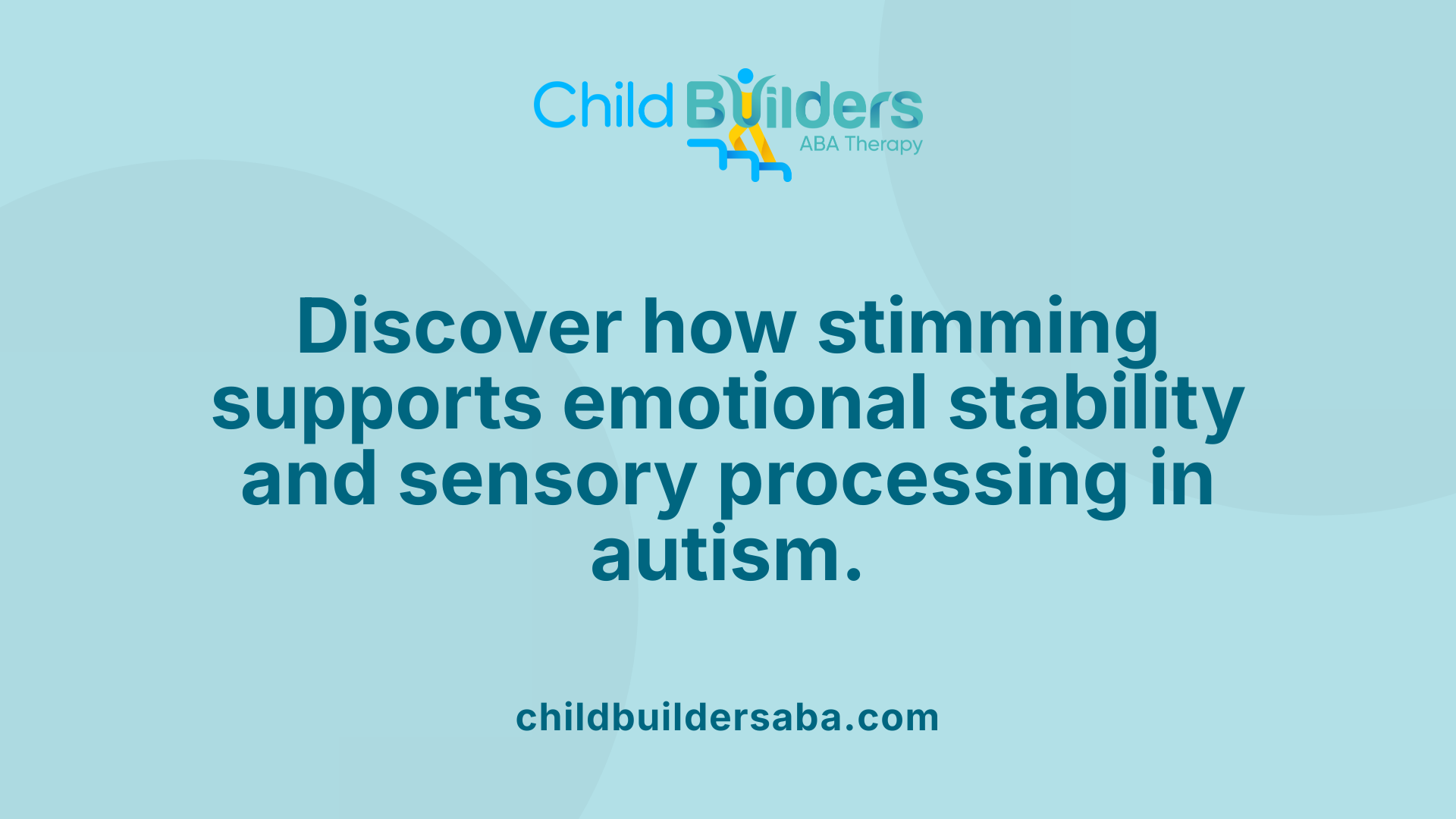Stimming In Autism

Introduction to Stimming in Autism
Stimming, a core characteristic of autism, encompasses a wide range of repetitive behaviors and movements that serve various functions for autistic individuals. Recognized as part of the diagnostic criteria, stimming is often misunderstood or misinterpreted, but understanding its purposes and nuances is vital for supporting neurodiversity. This article explores the types, causes, benefits, and management strategies for stimming, aiming to foster acceptance and practical approaches for caregivers, educators, and clinicians.
Common Examples of Stimming Behaviors in Autism
What are some common examples of stimming behaviors in autism?
Autistic individuals often engage in a variety of repetitive behaviors known as stimming. These behaviors help them regulate sensory input, express emotions, or reduce anxiety. Some of the most typical examples include hand-flapping, where the person rapidly moves their hands back and forth; body rocking, which involves rocking side to side or front to back repeatedly; and pacing or spinning objects to stimulate their visual senses.
Other common movements include tiptoe walking, toe-walking, or holding fingers in unusual postures. Vocal behaviors might involve humming loudly, repeating words or phrases (echolalia), or making specific sounds to self-soothe or express excitement. Visual stims can include watching spinning objects, fluttering fingers in front of their eyes, or staring at flashing lights. Oral behaviors such as chewing on objects, biting nails, or mouthing items are also prevalent.
Many individuals also seek out certain textures or smells, rubbing surfaces or sniffing objects. Although these behaviors vary widely, they serve important roles in helping manage sensory overload or emotional states. Recognizing these behaviors as natural coping mechanisms is crucial for providing support and understanding.
Triggers and Causes of Stimming in Autism
What causes or triggers stimming behaviors in autistic individuals?
Stimming behaviors in autistic people often result from a need to regulate sensory input. Many individuals stim to manage overwhelming or insufficient sensory signals, helping them feel calmer and more in control. For example, when sensory input becomes too intense — such as loud noises or bright lights — stimming can serve as a way to block out or modulate these stimuli.
In addition to sensory regulation, emotional and physical states play a significant role in triggering stims. Strong feelings like excitement, frustration, or anxiety can prompt repetitive actions or noises. Physical discomfort or tiredness may also lead to stimming as a coping strategy. These behaviors provide a form of self-soothing, reducing internal stress and helping individuals maintain emotional balance.
Environmental factors are notable influences. Unfamiliar settings, sudden changes in routine, or noisy environments can provoke increased stimming as a way to cope with feelings of uncertainty or overload. In some cases, stimming also expresses internal emotions such as joy or anger. Overall, these behaviors serve as adaptive tools, helping autistic individuals manage sensory, emotional, and physical challenges while fostering a sense of safety and stability.
Understanding what triggers stimming helps caregivers and professionals support autistic individuals better. By recognizing these underlying causes, they can create safer environments, offer appropriate sensory input, and develop personalized strategies to reduce harmful behaviors while respecting the individual's coping mechanisms.
Supporting Healthy and Appropriate Stimming

Is there support for healthy and appropriate stimming behaviors in autistic individuals?
Supporting healthy and appropriate stimming in autistic individuals involves understanding its often functional roles, such as self-regulation, emotional comfort, and sensory processing, rather than simply trying to suppress the behaviors.
Acceptance plays a vital role. Recognizing that stimming is a natural and meaningful way for many individuals to manage their sensory experiences and emotional states helps foster a more supportive environment. Especially when stimming is harmless, creating space for these behaviors allows individuals to feel comfortable and reduce stress.
In addition to acceptance, environmental modifications can help manage or support stimming. For example, providing quiet, sensory-rich spaces or offering alternative sensory activities like jumping on a trampoline or using weighted blankets can help meet sensory needs safely. These adjustments can reduce the likelihood of harmful or disruptive behaviors.
Behavioral strategies include identifying specific triggers—such as anxiety, overstimulation, or pain—and addressing them directly. When stimming behaviors are harmful or interfere with learning or social interaction, alternative coping mechanisms or safe replacements, like deep pressure or sensory toys, can be taught.
Educational efforts aimed at caregivers and educators are crucial. By understanding why a person engages in stimming, they can better support the individual's needs, promote emotional health, and help prevent unnecessary restriction of behaviors. Overall, the goal is to strike a balance: accepting stimming as a valuable tool while guiding individuals towards safe and constructive expressions.
This balanced approach enhances overall well-being, reduces stress, and helps autistic individuals express themselves freely while maintaining safety and comfort.
The Purpose and Benefits of Stimming in Autism

What is the purpose and benefit of stimming for autistic individuals?
Stimming acts as an important self-regulation method for many autistic people. It helps them manage intense sensory experiences, emotions, and internal stress. Whether it involves body movements, such as rocking or hand-flapping, or repeated sounds like humming, stimming provides sensory input that can be soothing or stimulating.
For some, stimming reduces feelings of overwhelm caused by sensory overload, giving a calming effect. In other cases, it offers sensory stimulation to under-responsive senses, helping individuals stay alert and focused.
Stimming also enables emotional expression. It can be a way to show joy, excitement, frustration, or anxiety. Many behaviors, like pacing or humming, serve as outlets for emotions that might be hard to express verbally.
Furthermore, pleasurable and repetitive stims can improve concentration and reduce anxiety levels. They serve as coping mechanisms during stressful situations or when facing unfamiliar environments.
Although some stimming behaviors may be disruptive or harmful—like head banging or extreme skin picking—the primary goal is often to address the root causes rather than dissuade the behavior entirely. Professionals and caregivers tend to focus on understanding why a person is stimming and finding safe ways to support their needs.
Overall, stimming in autism offers numerous benefits: it supports emotional stability, aids in sensory processing, and enhances overall well-being. Recognizing its value helps foster a more understanding and supportive environment for autistic individuals to thrive.
Development and Evolution of Stimming Over Time

How do autism-related stimming behaviors typically develop and change over time?
Autism-related behaviors involving self-stimulation, or stimming, usually appear in early childhood, often around age 3. During this stage, children begin to use repetitive movements and sounds as a way to self-regulate their emotions and sensory experiences. These behaviors might include hand-flapping, rocking, pacing, tapping, or vocalizations such as humming or echolalia. The primary functions of these behaviors are sensory stimulation, emotional expression, and managing overwhelming feelings or environments.
As children grow, the ways they stim often evolve. The intensity, frequency, or specific forms of behaviors can change as part of their development. Some individuals may learn to modify or control certain stims, especially with support from therapies or environmental adjustments. For others, stimming remains a consistent coping tool throughout life.
Environmental influences and therapeutic interventions can shape how stimming behaviors develop. For example, creating a calming space or engaging in occupational therapy can help manage or replace disruptive or dangerous stims with safer alternatives. Sometimes, behaviors become more socially acceptable or refined over time, such as replacing head-banging with hand-flapping. Despite changes, many autistic individuals continue to rely on stimming as a vital means of emotional and sensory regulation.
Supporting these behaviors through understanding and acceptance is essential. Stimming remains an important part of managing stress, sensory overload, and emotional expression for many autistic people, often becoming more adapted to their developmental stage and surroundings. This ongoing adaptation underscores the importance of patience and compassion in their support systems.
Interventions and Strategies for Managing Problematic Stimming

Are there effective intervention strategies to manage or reduce problematic stimming behaviors?
Yes, there are several approaches designed to manage or reduce behaviors that are disruptive, harmful, or unsafe. The core idea is to understand why the individual is stiming and address the root causes while promoting safety.
Behavioral methods, especially Applied Behavior Analysis (ABA), are commonly used. These techniques focus on reinforcing positive, more acceptable behaviors and decreasing harmful ones. For example, if head-banging is problematic, therapy might teach safer ways to self-stimulate.
Environmental adjustments play a crucial role. Creating calm, predictable settings helps reduce triggers like noise or chaos that often prompt harmful stims. Incorporating sensory tools—such as weighted blankets, fidget toys, or noise-canceling headphones—can help individuals self-regulate more effectively.
Encouraging alternative behaviors is another key aspect. Offering options like jumping on a trampoline, squeezing a stress ball, or deep pressure exercises can redirect the energy associated with stimming. These activities provide sensory input in a safe, controlled manner.
Physical activity is notably beneficial. Vigorous exercise can release excess energy and reduce the urge to stim in unsafe ways. Participating in sports or dance can serve as positive outlets.
Ultimately, the goal of these strategies is not to suppress stimming altogether but to guide it in ways that are safer and less disruptive. Supporting self-awareness and emotional regulation helps individuals cope better with overwhelming feelings or sensory overload, enhancing their overall well-being.
Supporting Caregivers and Educators

How should caregivers and educators support autistic individuals in their use of stimming behaviors?
Supporting individuals on the autism spectrum in their stimming activities involves a balance of understanding, acceptance, and practical strategies. First, it's essential to recognize that stimming is a natural and helpful behavior, serving functions like sensory regulation, emotional expression, and stress relief. By accepting stimming as part of neurodiversity, caregivers and teachers can foster a more inclusive and understanding environment.
Creating supportive spaces plays a vital role. Providing sensory tools such as fidget toys, weighted blankets, or access to quiet areas allows individuals to stim safely and comfortably. Incorporating sensory breaks into daily routines can help manage overload and reduce the need for potentially harmful behaviors.
Understanding the reasons behind why an individual stimms is crucial. If a behavior is disruptive or harmful, teaching alternative, acceptable coping methods—like deep breathing or using sensory objects—can help. It’s equally important to avoid punishing or suppressing stimming, as doing so can increase anxiety and hinder emotional regulation.
Raising awareness among staff, peers, and the wider community reduces stigma and encourages acceptance. Education about the purpose and benefits of stimming helps foster empathy and understanding.
Individualized approaches are most effective. Tailoring support to each person’s preferences and communication style ensures they feel respected and understood. Ongoing collaboration with professionals like occupational therapists or behavior analysts can further optimize strategies.
In summary, fostering an environment that accepts, understands, and accommodates stimming behaviors not only supports the well-being of autistic individuals but also promotes their independence and confidence.
The Ethical Perspective: Suppressing Stimming and Its Implications
Is it advisable to try to stop or suppress stimming behaviors in autistic individuals?
Most experts and advocates agree that attempts to stop or suppress stimming behaviors should be approached with caution. Stimming, or self-stimulatory behavior, plays a vital role in how many autistic people manage sensory input, emotions, and stress.
These behaviors often help individuals self-regulate, reduce sensory overload, and express internal states of joy, excitement, or relief. Suppressing them can lead to increased anxiety, stress, and a higher likelihood of emotional burnout.
For instance, if a child with autism flaps their hands or rocks back and forth to calm themselves or block out overwhelming noise, discouraging these actions might leave the child feeling more overwhelmed and less able to cope.
Therefore, it is generally recommended that interventions do not focus solely on eliminating stimming. Instead, understanding why a behavior occurs and creating a supportive environment that respects the individual's needs is crucial.
When stimming behaviors are harmful or significantly disruptive—such as head banging or biting—caregivers and professionals should seek safer alternatives. These might include providing sensory tools, creating calming spaces, or offering acceptable physical activities like jumping on a trampoline.
In summary, efforts should prioritize acceptance and support over suppression, ensuring that autistic individuals feel safe, understood, and able to use stimming as a healthy coping mechanism.
Fostering Acceptance and Support
Understanding and supporting stimming behaviors as a natural and functional aspect of autism is essential for promoting well-being and inclusion. Recognizing the diverse forms of stimming, their triggers, and purposes enables caregivers and professionals to create environments that respect individual needs. Emphasizing acceptance, employing tailored interventions, and educating communities can foster a supportive atmosphere where autistic individuals feel empowered to express themselves fully. Ultimately, the goal is to balance safety with acceptance, ensuring that stimming remains a helpful tool for emotional regulation, sensory processing, and self-expression across the lifespan.
References
- Stimming: What Is It and Does It Matter? | CHOP Research Institute
- What is Stimming In Autism? – Lighthouse Autism Center
- Stimming and autism - Leicestershire Partnership NHS Trust
- Repeated movements and behaviour (stimming)
- Stimming: Causes and Management - Healthline
- Stimming and Autism: Are They Related? - WebMD
- Autism and Stimming - Child Mind Institute
- Stimming: autistic children and teenagers - Raising Children Network
- Stimming FAQ: What is Autism Stimming? Types, Examples & Causes





.jpg)































































































